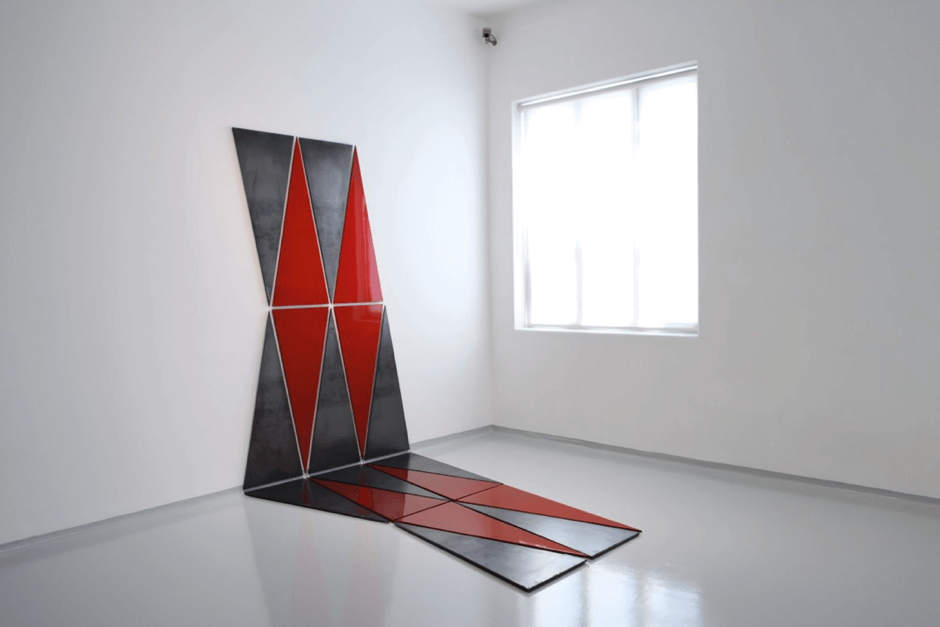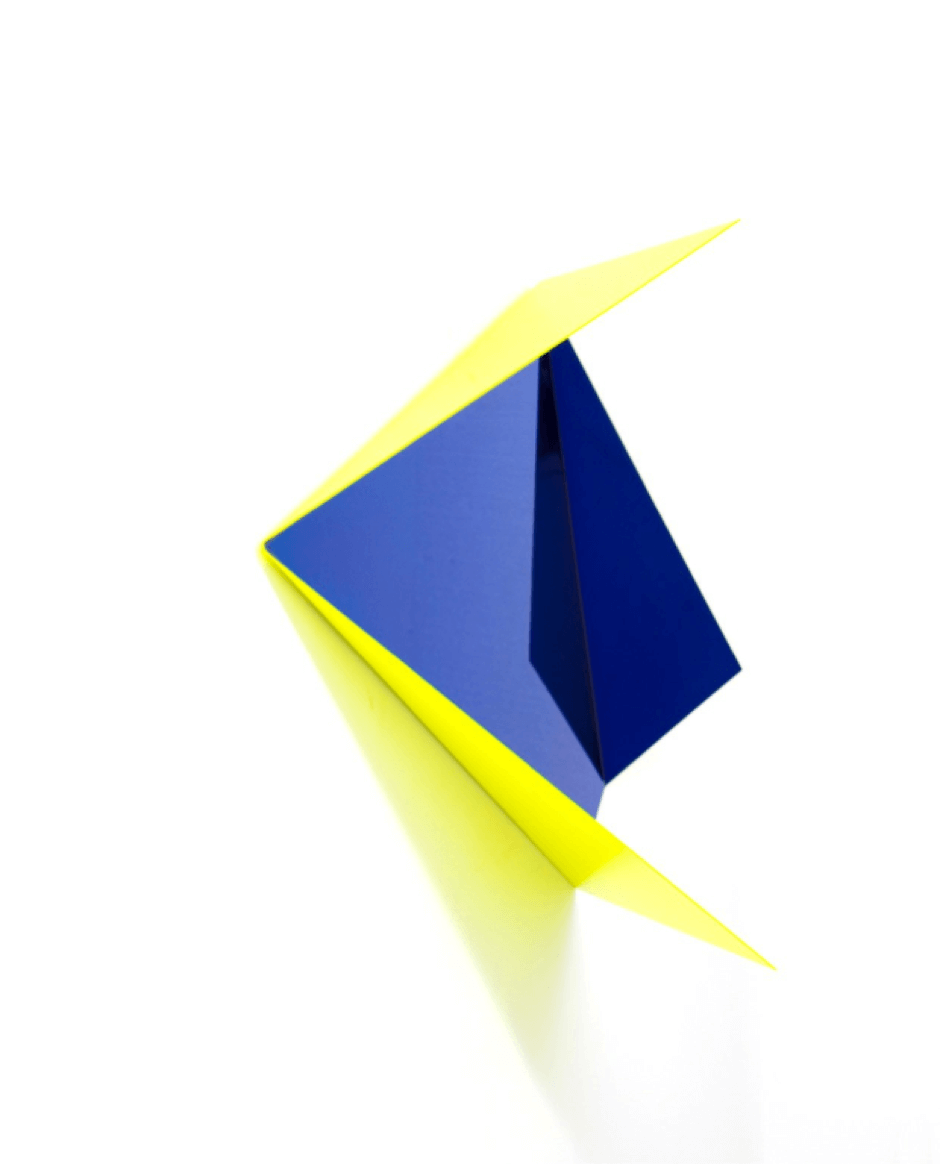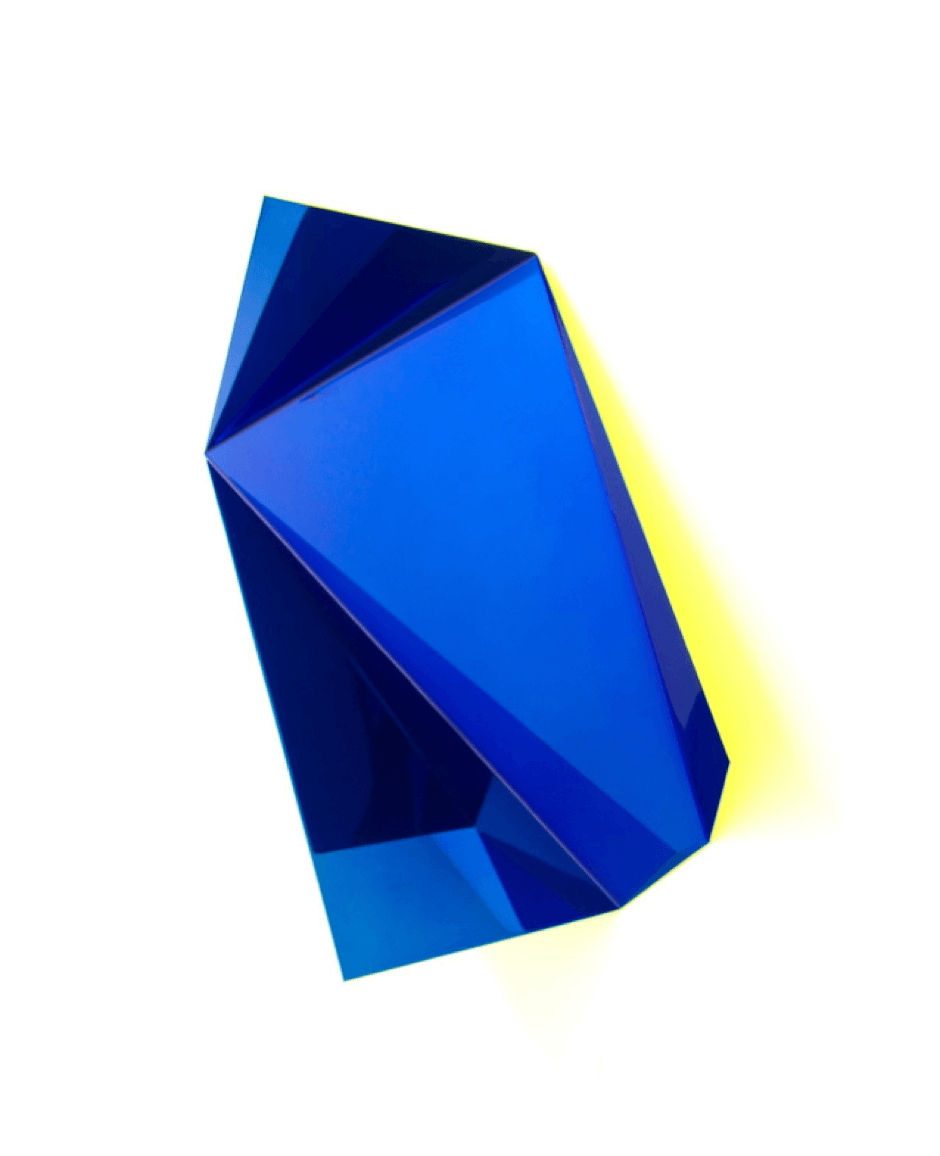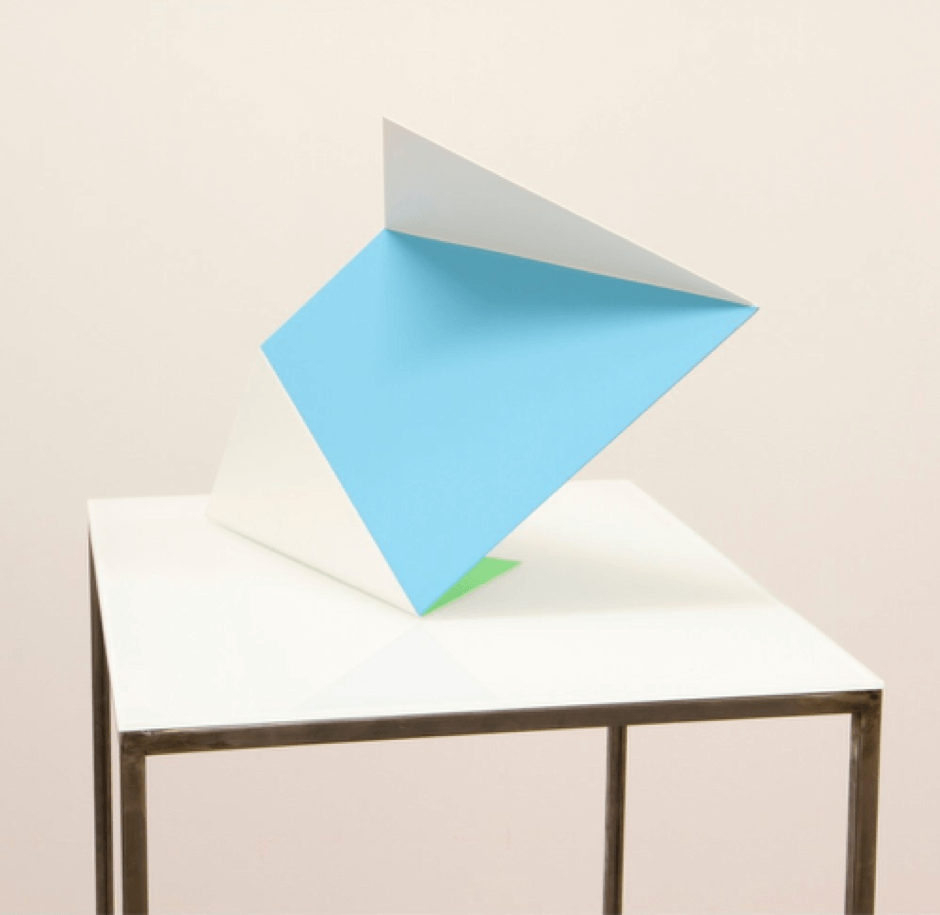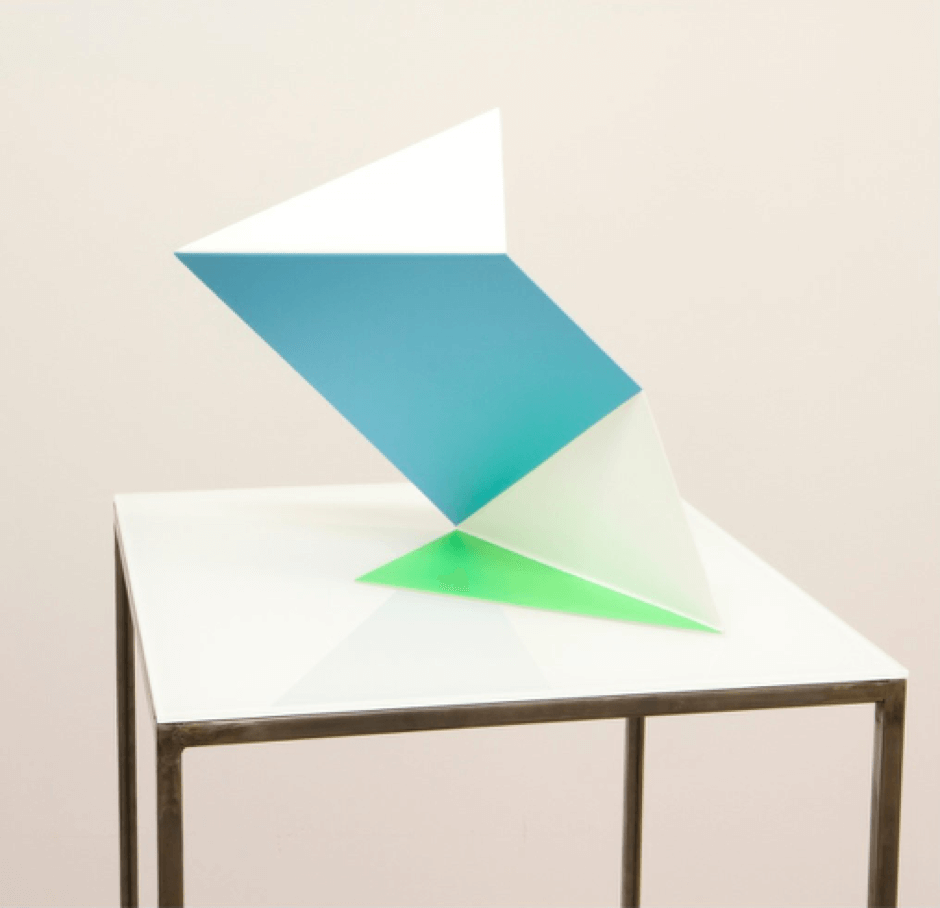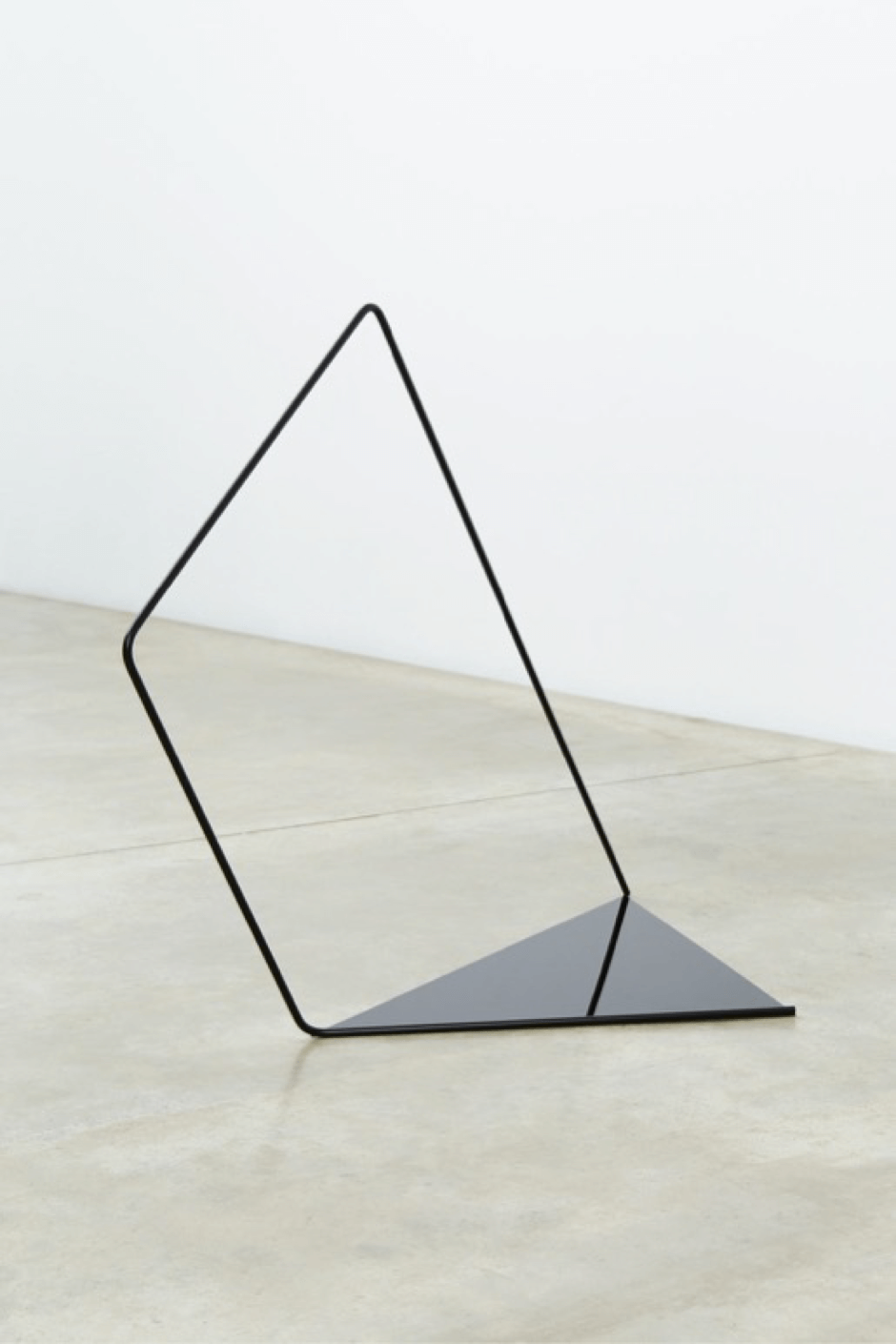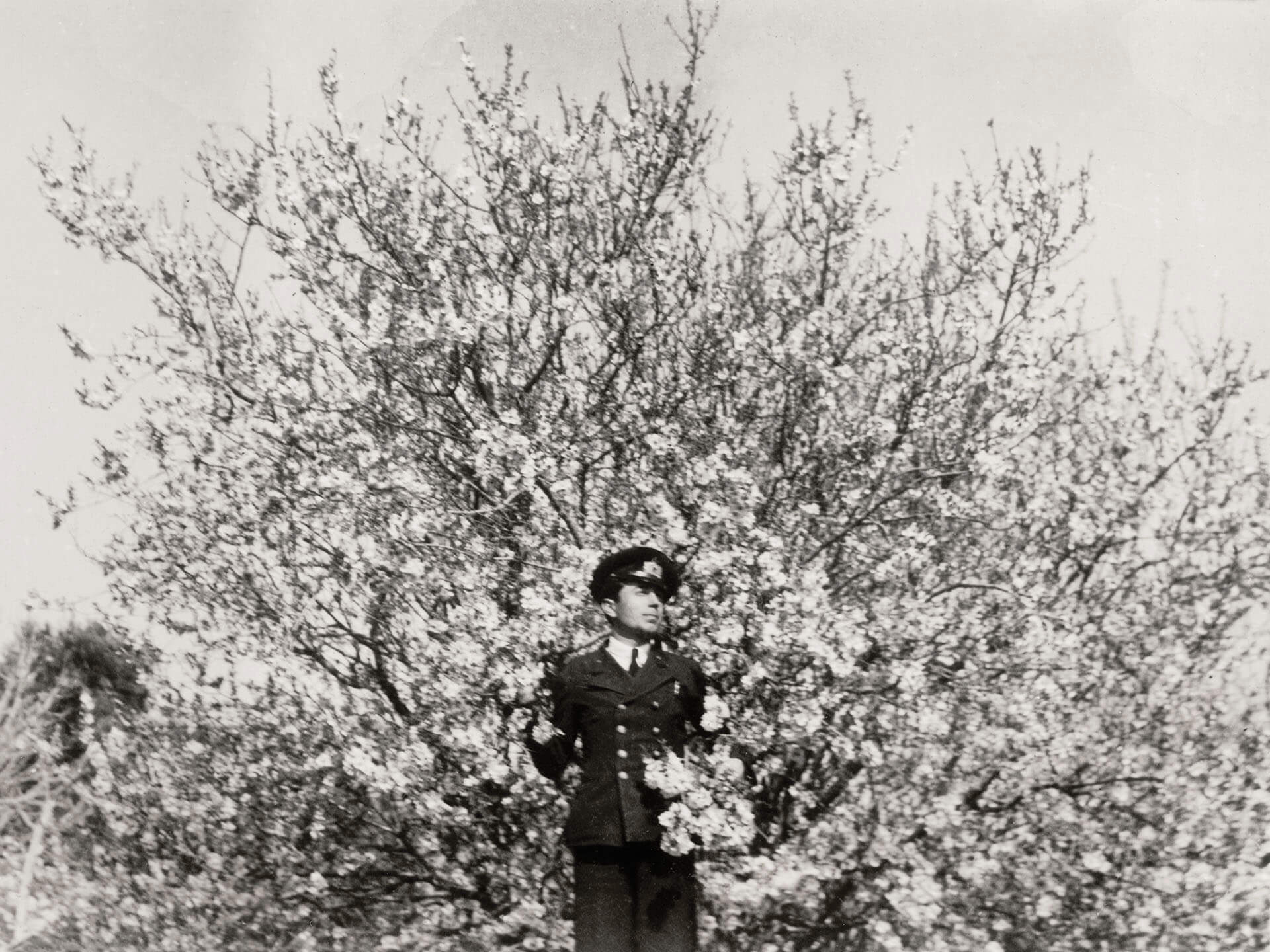“The modular nature of the works mean that they may be perceived as a section of something that could be much larger. This idea of the infinite, fluidly extending vertically or horizontally into space is an important quality of my works.”
In her upcoming exhibition at Sainsbury Visual Arts Centre, Begum’s use of space, colour and form will transform the Mezzanine Gallery with an immersive installation and wall-mounted reliefs, taking advantage of the light and space of Norman Foster’s architecture. This will be her first museum show. Rana Begum has completed a sizeable number of public and private commissions in the UK and abroad. Since Parasol Unit’s exhibition last year in London, she has been awarded the prestigious Abraaj prize as part of Art Dubai 2017.
Your work has been associated with art history movements like constructivism and minimalism. How much do you actually relate to that?
A lot! I was introduced to constructivism, minimalism and abstraction during my foundation course. I was studying a range of disciplines: painting, drawing, printmaking, etc. My drawings had this architectural quality and while studying sculpture, I began welding and producing structures which were also very architectural. At that point one of the tutors took me to the library and showed me works by artists such as Charles Biederman, Mary Martin and Kenneth Snelson. I was in awe of what I was seeing; how they were capturing light and how the work appeared to be in constant motion. My tutor also showed me work by Donald Judd and Sol LeWitt and I remember thinking, “How do I get there?”. It wasn’t as simple as making a sudden jump from representational to abstract art. Rather, I looked at these artists and then analysed my own work through this new lens. I specifically concentrated on my drawings as they were my strongest work at that point, using them as a compass for forming a new visual language.
Through dissecting my drawings, I found that they already employed many of the components that I had identified in constructivist and minimalist art. They utilised the same elements of light, form, structure and colour but in a chaotic way. In order to truly understand those artists and what it was that had so moved me about their work, I felt the need to go back to basics. I made a mental list of the elements that I was excited about within my own work, then I stripped it back and focused on natural light and form.
During my degree, I spent about 4-5 years working purely on light and form. I was trying to understand material and mass and how light affected the different qualities of surface and texture. After having considered these two elements at length, I felt ready to explore colour. However, I knew that I couldn’t just suddenly introduce colour to the work I had already created. Instead, I explored colour in isolation, discovering how one hue may affect the other and that, even by applying an incredibly thin strip of colour to my work, exciting and unexpected changes occurred.
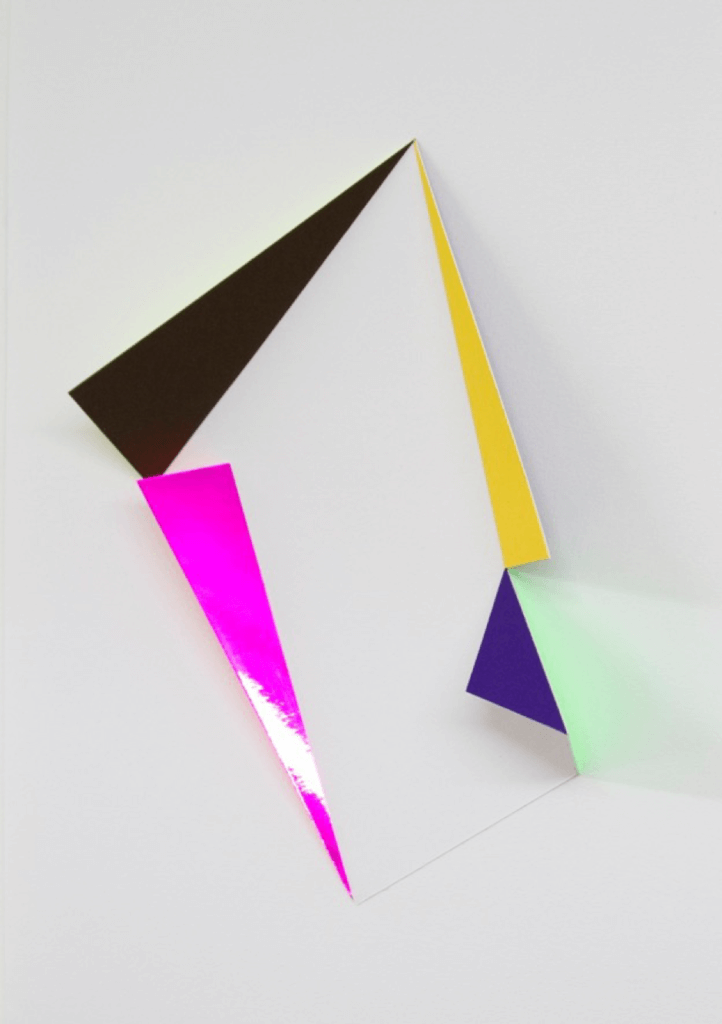
Paper
H42 x W29cm
You have used well-crafted materials as well as more ordinary ones like straws and adhesive. What attracts you to those materials?
My early works were produced with various types of adhesive tapes. This was a satisfying, instantaneous material to use – I could make decisions quickly and see the results right away. However, when people started showing interest in buying these works, I knew that I couldn’t sell them because they would fall apart. I spent a year researching ways in which I could keep the tape bonded to the surface. Resin provided the solution and, though primarily functional, it also became an aesthetic part of the work, reflecting the space the work was situated in. This triggered a desire for the work to become more sculptural and protrude from the wall – this allowed it to engage more fully with its environment.
In such a methodical approach, how do you go from light, form and colour into the three dimensions of space?
It wasn’t instant and it wasn’t easy! Firstly I had to feel really confident about my use of light and form before I could start introducing colour. Next, I needed to come to grips with these elements in tandem before making what now feels like an inevitable move to three-dimensional space. While I was doing some work using hazard tape, which builders and police use to cordon off areas, I was acutely aware of the 3-dimensional quality this flat material can lend to space. However, at that stage I didn’t feel confident enough to make the leap – that came later!
“I don’t want to make works that the viewer can only experience from one angle. Rather, I aim to create the same experience that you get when walking through a city, seeing things constantly shift and change.”
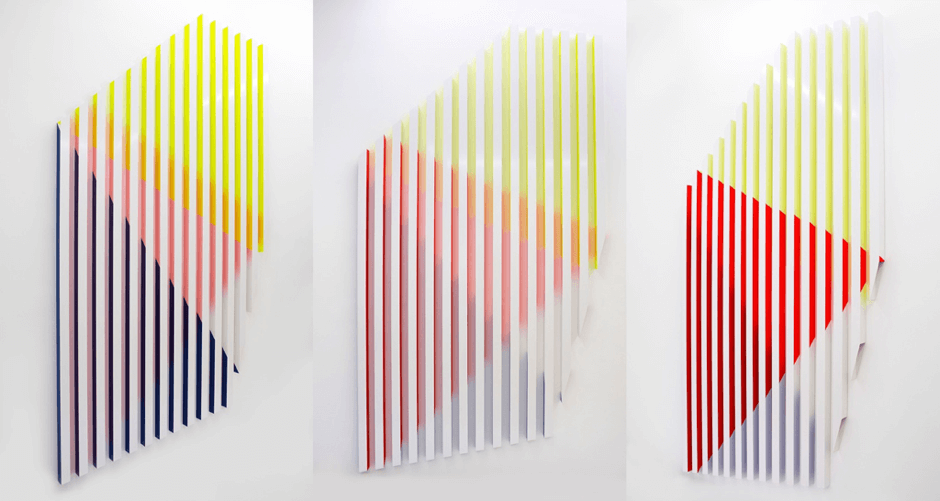
Paint on powder-coated aluminium
H206 x W145 x D5cm
The idea of fluidity is very rich in your work because of the change that viewers experience when they move around it but sometimes change is also embedded within the material, such as where steel is left raw and starts to rust.
I don’t want to make works that the viewer can only experience from one angle. Rather, I aim to create the same experience that you get when walking through a city, seeing things constantly shift and change. Through this shift and change, sometimes there is a moment of alignment when form and light seem to fall naturally into place. I try to recreate these moments in my work. The modular nature of the works mean that they may be perceived as a section of something that could be much larger. This idea of the infinite, fluidly extending vertically or horizontally into space is an important quality of my works.
The development of your work seems very rational and structured. Is there any time when chance has played a role?
Yes, chance has played a critical part in the development of my work! For example, I had a very low ceiling in my old studio and was preparing work for a show. There was one particularly large piece which I couldn’t hang up until I got it into the exhibition space. Once it was installed, I thought it was a disaster! I had used solid colour but the light was mixing it, creating a third layer of colour and geometry. My intention had been to simplify everything – I wanted the work to become distilled and pure but instead it was going the opposite way, becoming more complex. It was too late for me to change it so I had to leave it up on the wall. However, the more I looked at it, the more excited I became by the geometry within the colours. I had thought my study on colour was over but in fact it was just opening up.
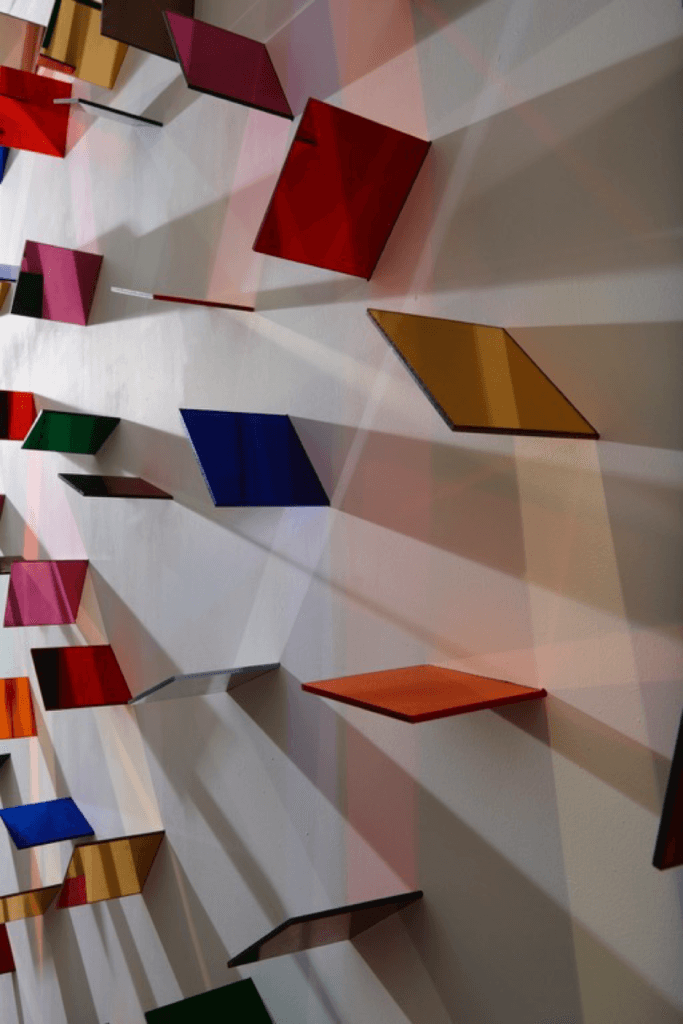
Coloured perspex and light
Dimensions variable
I wouldn’t have intuitively thought that a UK-based artist would be inspired by light given the little we get and the poor quality of it.
Not at all, we get amazing variations of light here! It is these variations that make natural light such a rich source of inspiration for me. The work adsorbs and reflects the light and therefore is affected by its dramatic changes throughout the day. You never know what sort of light you will get next – in an instant it can change from bright and crisp to soft and diffused. This means that the work rarely looks exactly the same – there is always something to discover.
I grew up in Bangladesh and I still remember the light there. The basket installation I created for the art summit in Dhaka was inspired by this experience of light. In the same way, when I was thinking about the proposal for The Abraaj Group Art Prize, I was thinking about the nature of the light in Dubai. I wanted that work to be outdoors because I wanted Dubai’s light to be an integral part of the work.
In some cases, there is a strong simplicity in the use of colour, whilst in others there is a huge diversity and eclectic range. Is there a symbolism in the choices or maybe some rules that you follow?
There is no hidden narrative when I choose colours – it is very instinctive. I tend to base decisions on how one colour reacts to, or interacts with, others. That is what is exciting for me. I draw inspiration from what I see in the streets. I love the way colours and form clash or interact with each other. On city streets, choice of colour is rarely made by considering how it relates to the building next door. Rather, it is based on how that colour may present a unique idea or product. This creates fantastic clashes and contrasts of colour which feed directly into my work. The contrasting primary colours of Islamic art and architecture have also featured in my work from an early stage and I explore how fluorescent colours react with pastels as you can see in my fold series and bar works.
“I have always been drawn to man-made, industrial materials. I love materials that have an everyday function such as reflectors. There is an aesthetic quality to them that can be lost through functionality. However, once part of an art work, we become aware of the beauty of these commonplace items.”
I find the simplicity of the folding gesture very alluring. Could you tell me more about the Fold series?
In a city, you are immersed in a matrix of architecture, light and colour. These components deeply inform the Fold series be they wall-based or freestanding. The Folds started as a series of studies, exploring drawing in a physical way but they soon became works in their own right. The three-dimensional forms that arose from these studies allowed me to capture other key elements – colour and interaction. I was intrigued by the way the folded paper caught the light and created shadows; the white was no longer white, colour slowly took form as I folded the paper. Transitioning from paper to sheets of copper and mild steel, this sense of paper-lightness is maintained through the reflections cast by the work’s fluorescent reverse.
The attention to detail and the execution of your extremely well-crafted work is hardly usual and yet the materials that you use are very industrial…
I have always been drawn to man-made, industrial materials. I love materials that have an everyday function such as reflectors. They are made for a purpose but through being used to create works of art, they become something else entirely. There is an aesthetic quality to these materials that can be lost through functionality. However, once part of an art work, we become aware of the beauty of these commonplace items. The bar pieces are made from extruded aluminium, more commonly found on construction sites. When I ordered them for the first time the supplier found it very strange that I wanted them to be individually wrapped to prevent them from getting scratched!
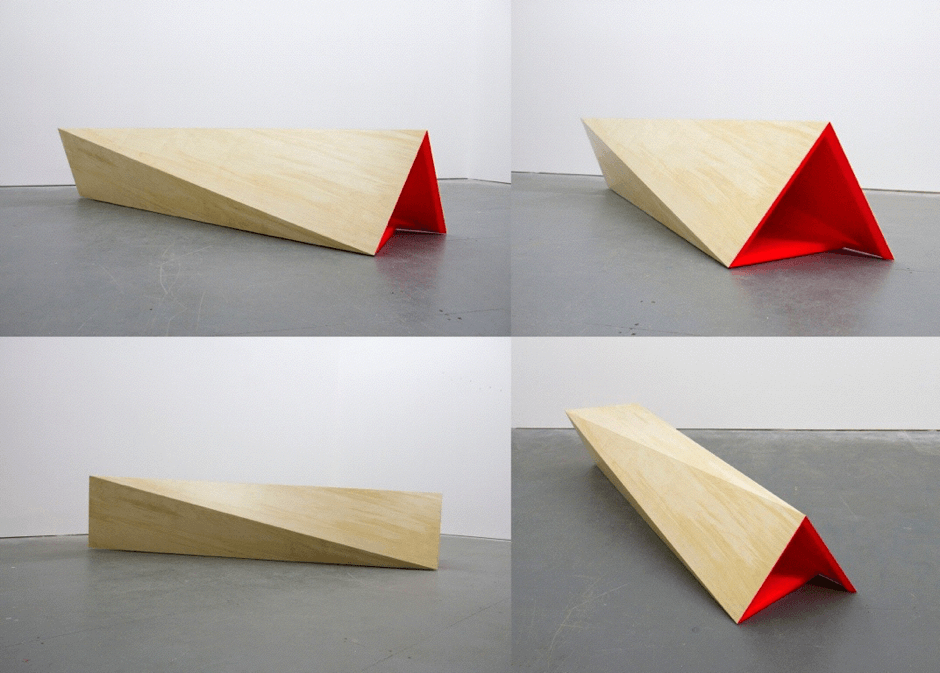
Paint , lacquer on birch ply
W220 x H45 x D50cm
You mention functionality. The works that you make seem to have some functionality or maybe you hint at the possibility that in the future you may go there. Would you like to explore associating your practice to design, architecture, etc.?
Definitely! For the Surbiton Health Centre and my public work pieces, the site and viewer is key. When designing each piece I have to consider how the artwork will create a dialogue with the surrounding space and how I can make that dialogue relevant to the viewer. This way of thinking brings my practice much closer to the realm of architecture and urban design.
It is important to me that neither I nor my work becomes hemmed in or pigeonholed. I did fine art painting during my BA and MA because it also allowed me to work in sculpture, design and architecture without any restriction between disciplines; painting allowed me to stay open, to explore diverse materials and form a relationship with both sculpture and architecture.
Is there an idea or concept that you have in mind which you would like to materialise in the near future?
Initially, I thought that my most recent work for the 2017 Abraaj Group Art Prize was unlikely to be accepted as it involved displaying a glass work with sharp edges in a public space. To my surprise and delight it was accepted and these challenges were overcome by placing the work on a plinth in water. However, unfortunately this means that people can’t get very close to the work. This is a bit disappointing for me as walking around and through the work provides the viewer with very different experience to observing it from a distance.
However, I was delighted to see such a large-scale work being realised. As we’ve discussed, the interplay between light and colour has always been central to my practice but the 2017 Abraaj Group Art Prize work, with its outdoor setting brought this interaction between colour, form and natural light to a new level. In the wake of this installation, I am very excited about where the work will go next. I would love to create a piece that is even more physical, providing a truly immersive experience for the viewer.

Coloured laminated glass
H 120 x W900 x L1400 cm
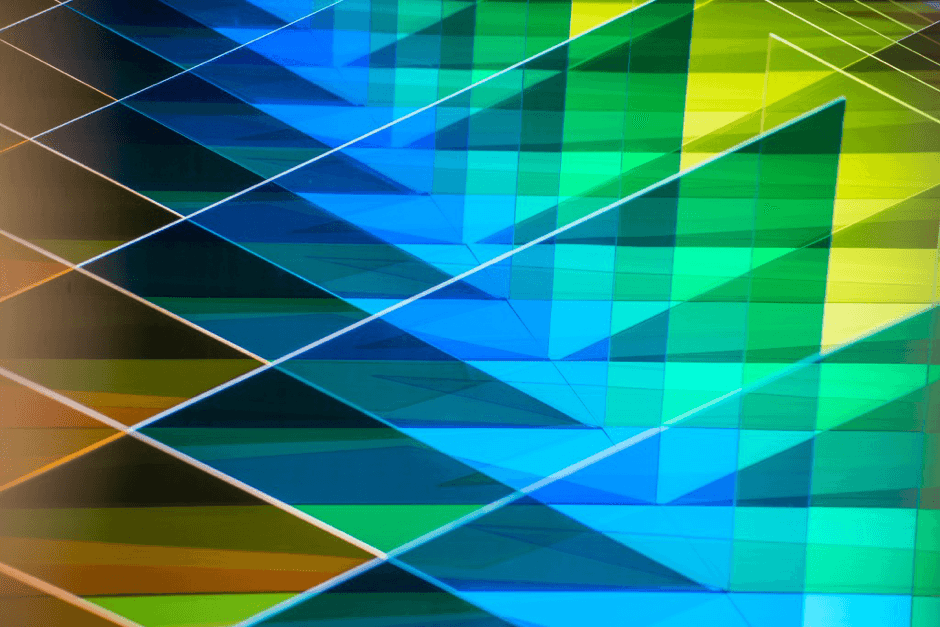
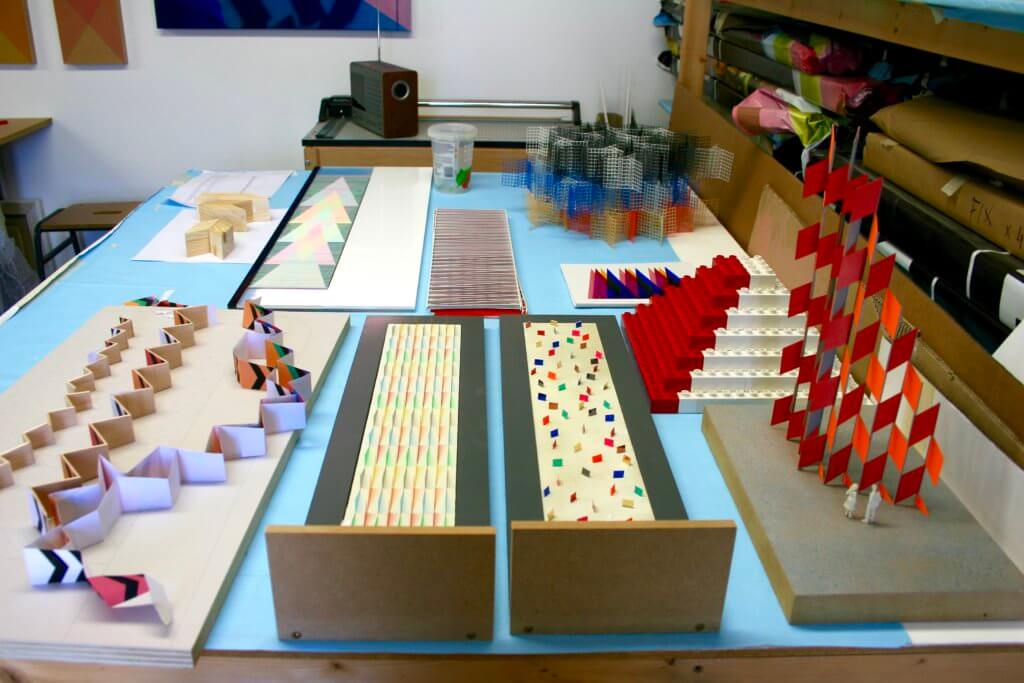
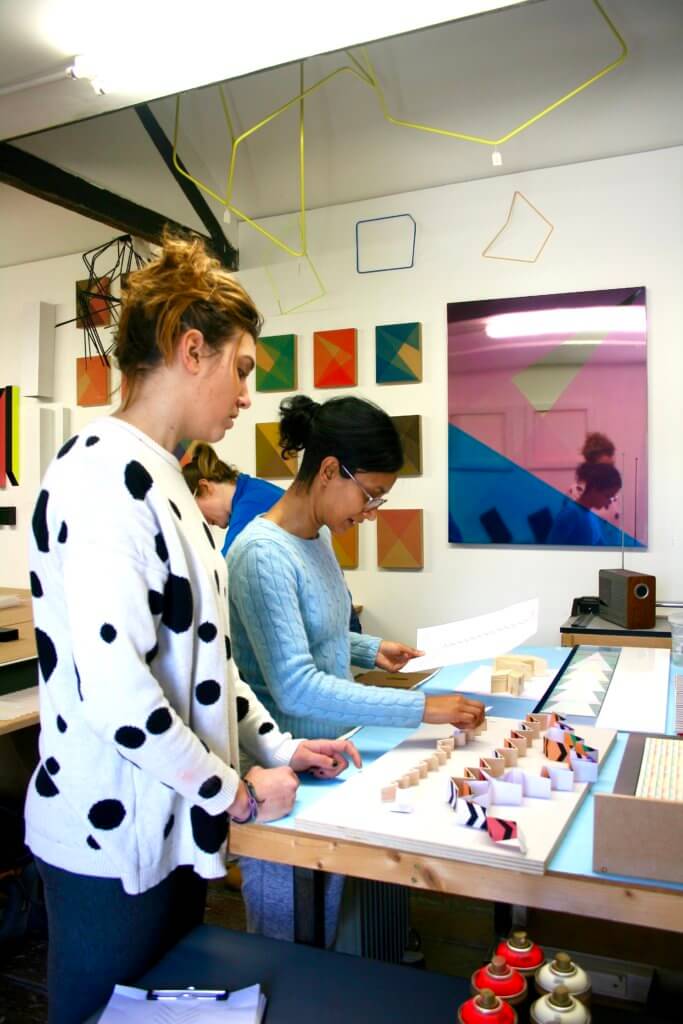
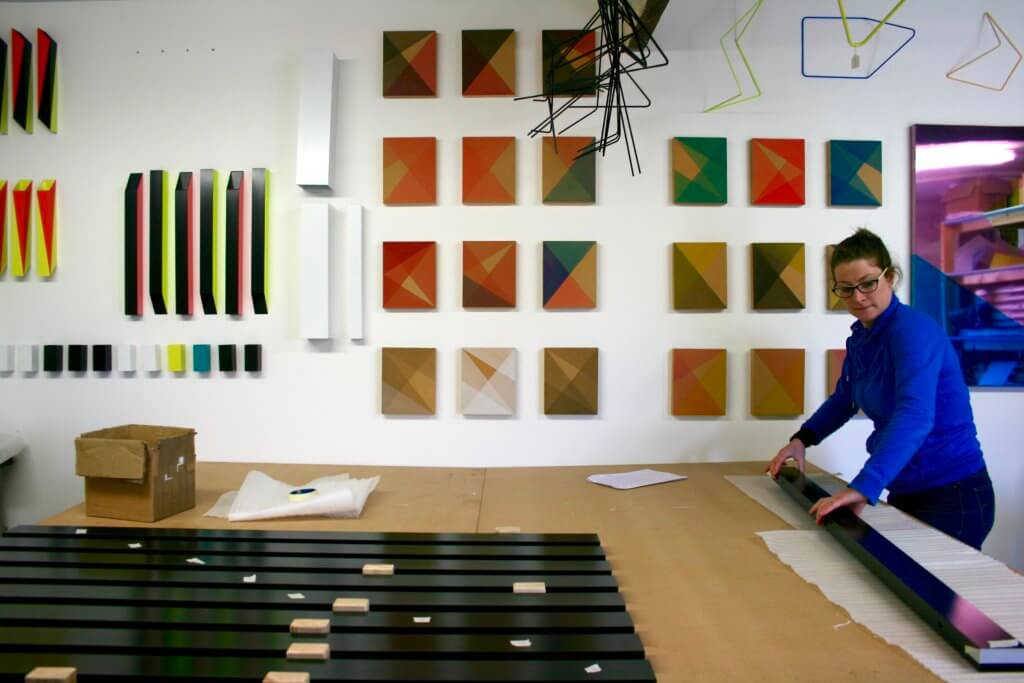 All images are courtesy of the artist. Rana Begum: Space Light Colour exhibition at Sainsbury Centre for Visual Arts, Norfolk, opens 12 May through 1 October 2017.
All images are courtesy of the artist. Rana Begum: Space Light Colour exhibition at Sainsbury Centre for Visual Arts, Norfolk, opens 12 May through 1 October 2017.

